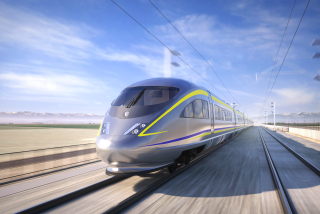Funding Plan for Simi-L.A. Commuter Line Offered
- Share via
In an effort to get his proposed Simi Valley-to-downtown-Los Angeles commuter train on track, state Sen. Alan Robbins (D-Van Nuys) on Tuesday proposed diverting some money earmarked for San Fernando Valley Metro Rail construction to subsidize the Amtrak-operated service.
A state transportation official said that, if the Legislature and the governor agree with Robbins’ plan, there could be enough money available to operate a commuter service on Southern Pacific railroad tracks that cross the Valley diagonally from Burbank Airport to Chatsworth en route to Simi.
“It’s an interesting and creative idea,” said Pete Hathaway, deputy director of the California Transportation Commission.
“It just might close the funding gap that we have been concerned about,” he said.
In August, Robbins won wide support among local elected officials for his proposal to extend Amtrak trains now operating between San Diego and Los Angeles north to Simi Valley while the Ventura Freeway is being expanded.
Under Robbins’ proposal, San Diegan trains would make three round trips daily between Simi Valley and Union Station in Los Angeles, stopping at Glendale, Burbank, Van Nuys and Chatsworth. Robbins on Tuesday proposed subsidizing the Amtrak trains with interest from a trust fund expected to be created soon for Valley subway construction. He predicted that there would be no opposition to the diversion of interest income to the commuter service and that the service “will go into operation and will be a big success.”
Trust Fund Interest
Robbins estimated the interest from the fund would be $1 million the first year and would grow to $3 million by the third year.
Under a law that Robbins sponsored in 1984, the Southern California Rapid Transit District, which is building Metro Rail, must spend $74 million over the next seven years on subway construction between Universal City and the intersection of Chandler and Lankershim boulevards in North Hollywood.
The law required the RTD to have begun construction by Sept. 29. RTD officials let the deadline pass without complying after Robbins announced he would sponsor a bill to grant a two-year delay, with the money for Valley construction to be held in trust.
Robbins proposed the delay in response to pressure from Studio City and North Hollywood residents who complained they would be forced to endure the noise and congestion of subway construction even though it is expected to be years before the Valley’s leg is connected to downtown.
Deadline Delayed
Both Robbins’ original deadline for Valley subway construction and the two-year delay he proposed last fall had strong support among Valley elected officials.
Hathaway said a staff report to be delivered to the California Transportation Commission’s Jan. 22 meeting is pessimistic about the feasibility of getting the Amtrak service started.
The report says that talks with Southern Pacific and Amtrak indicate that the state could come up with $3.5 million a year to operate the service and that operational costs would be $2.5 million.
However, Southern Pacific has demanded several million dollars in new sidings and other track improvements, Hathaway said, “and we cannot find a source of money for that work, which SP says is essential to keep its freight operations going smoothly.”
Hathaway said the use of interest from Valley subway money “might put the project in the black, although it is a bit odd to use Metro Rail funds to subsidize another type of service in a different corridor.”
Southern Pacific spokesman Jerry Pera said the commission staff’s “version of our position sounds essentially correct. We are willing to have our tracks used if we are reimbursed for needed improvements.”
Pera said he could not confirm or deny specific cost figures.
Amtrak already is scheduled to begin operating one San Diegan train to Santa Barbara within the next month, and part of Robbins’ plan is to adjust the departure times of the train to serve rush-hour commuters.
The other two round trips each day could be created by using San Diegan trains during “dead time,” when they are sitting at Union Station before returning to San Diego.
Los Angeles, Burbank and Simi Valley have indicated a willingness to contribute to the service.
In a related development, Robbins said he would amend his Metro Rail bill next week to eliminate a provision prohibiting the Los Angeles County Transportation Commission from constructing a light-rail line in North Hollywood and Van Nuys.
Bill Held Up
The controversial provision, supported by homeowner groups and opposed by Valley business groups, was responsible for stalling the bill in September on the final day of the 1987 session.
Robbins said the provision is “no longer needed because the County Transportation Commission has seen the light.” He referred to the commission’s Nov. 18 decision to drop consideration of five proposed light-rail routes for the Valley.
Unlike the diesel-powered Amtrak commuter trains, which run on existing tracks, light-rail trains operate on special light-gauge tracks and draw power from overhead electric lines.
More to Read
Sign up for Essential California
The most important California stories and recommendations in your inbox every morning.
You may occasionally receive promotional content from the Los Angeles Times.













